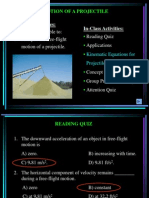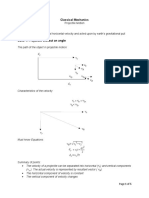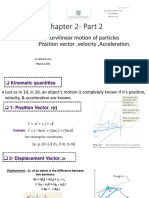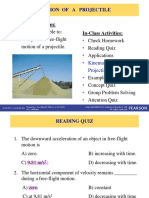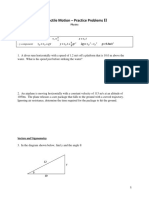Projectile Motion
g
~
ax = dvx/dt = 0
vx = vx,o
x = vx,o t + xo
ay = dvy/dt = -g
vy = vy,o - gt
y = yo + vy,o t - gt2
2
Friday, November 11, 2011
�Projectile Motion
g
~
ax = dvx/dt = 0
vx = vx,o
x = vx,o t + xo
ay = dvy/dt = -g
vy = vy,o - gt
y = yo + vy,o t - gt2
2
Friday, November 11, 2011
�Projectile Motion
y
x
g
~
ax = dvx/dt = 0
vx = vx,o
x = vx,o t + xo
ay = dvy/dt = -g
vy = vy,o - gt
y = yo + vy,o t - gt2
2
Friday, November 11, 2011
�Projectile Motion
Friday, November 11, 2011
�Example
Given: Given vo and , find the equation
that defines y as a function of x.
Use vx = vo cos and vy = vo sin
x
x = (vo cos )t or t =
vo cos !
y = (vo sin ) t g (t)2
Eliminate t:
y = (vo sin !) {
Friday, November 11, 2011
x
} g {
vo cos !
2
x
}2
vo cos !
�Example 2
Projectile is fired with vA=150 m/s at point A.
The horizontal distance it travels (R) and the
time in the air.
Friday, November 11, 2011
�Example 2
Projectile is fired with vA=150 m/s at point A.
The horizontal distance it travels (R) and the
time in the air.
Establish a fixed x, y coordinate system (in this solution, the
origin of the coordinate system is placed at A). Apply the
kinematic relations in x- and y-directions.
Friday, November 11, 2011
�Example 2
1) Place the coordinate system at point A.
Equation for horizontal motion.
xB = xA + vAx tf where xB = R, xA = 0, vAx = 150 (4/5) m/s
R = 120 tf
Friday, November 11, 2011
Time of flight: tf
�Example 2
1) Place the coordinate system at point A.
Equation for horizontal motion.
xB = xA + vAx tf where xB = R, xA = 0, vAx = 150 (4/5) m/s
R = 120 tf
Time of flight: tf
2) Now write a vertical motion equation. Use the distance equation.
yB = yA + vAy tf 0.5 g tf2
where yB = 150, yA = 0, and vAy = 150(3/5) m/s
We get the following equation: 150 = 90 tf + 0.5 ( 9.81) tf2
Friday, November 11, 2011
�Example 2
1) Place the coordinate system at point A.
Equation for horizontal motion.
xB = xA + vAx tf where xB = R, xA = 0, vAx = 150 (4/5) m/s
R = 120 tf
Time of flight: tf
2) Now write a vertical motion equation. Use the distance equation.
yB = yA + vAy tf 0.5 g tf2
where yB = 150, yA = 0, and vAy = 150(3/5) m/s
We get the following equation: 150 = 90 tf + 0.5 ( 9.81) tf2
Solving for tf first, tf = 19.89 s.
Then, R = 120 tf = 120 (19.89) = 2387 m
Friday, November 11, 2011
�Example 3
y
x
A skier leaves the ski jump ramp at A
= 25o and hits the slope at B. Find the
Skiers initial speed, va.
Motion in x-direction:
Using xB = xA + vox(tAB) => (4/5)100 = 0 + vA (cos 25) tAB
tAB=
Friday, November 11, 2011
80
vA (cos 25)
88.27
vA
�Example 3
Motion in y-direction:
Using yB = yA + voy(tAB) g(tAB)2
88.27
64 = 0 + vA(sin 25) {
} ! (9.81) { 88.27 }2
vA
vA
vA = 19.42 m/s
Friday, November 11, 2011
�Do it in your head
1. In a projectile motion problem, what is the maximum number of unknowns
that can be solved?
A) 1
B) 2
C) 3
D) 4
Friday, November 11, 2011
�Do it in your head
1. In a projectile motion problem, what is the maximum number of unknowns
that can be solved?
A) 1
B) 2
C) 3
D) 4
2. The time of flight of a projectile, fired over level ground, with initial
velocity Vo at angle , is equal to?
A) (vo sin )/g
B) (2vo sin )/g
C) (vo cos )/g
D) (2vo cos )/g
Friday, November 11, 2011
�Do it in your head
3. A projectile is given an initial velocity
vo at an angle above the horizontal.
The velocity of the projectile when it
hits the slope is ____________ the
initial velocity vo.
A) less than
C) greater than
Friday, November 11, 2011
B) equal to
D) None of the above.
�Do it in your head
3. A projectile is given an initial velocity
vo at an angle above the horizontal.
The velocity of the projectile when it
hits the slope is ____________ the
initial velocity vo.
A) less than
C) greater than
B) equal to
D) None of the above.
4. A particle has an initial velocity vo at angle with respect to the horizontal. The
maximum height it can reach is when
A) = 30
B) = 45
C) = 60
D) = 90
Friday, November 11, 2011
